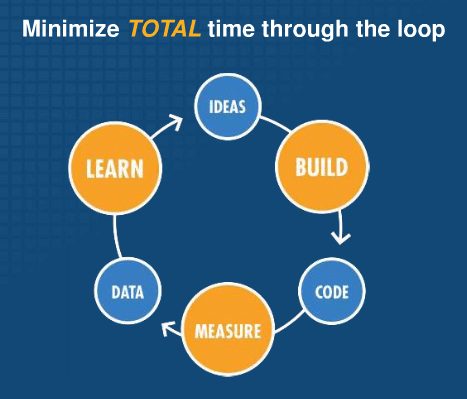The Michigan Lean Startup Conference brought some of the thought leaders of lean startup to Grand Rapids a few weeks ago. The talks were excellent. I particularly enjoyed listening to Eric Ries on the lean startup concept and William Pietri’s perspective on temporary versus sustainable code. Jeffrey Schox explained the complicated business of IP in a refreshingly clear fashion.
Unfortunately, some of the comments I heard from the audience, the tweet stream, and at the after-party made me think there were two big misunderstandings common in the audience:
1. Lean startup just means shoestring budgets.
2. Lean startup is for web businesses only.
It seems to be a common misconception that lean means cheap. It reminds me of the old confusion about agile being the same as ad-hoc. What I hear and understand is that lean startup is a strategy for faster validated learning. Eric Ries’s simple graphic says it all:
It stands to reason that if you can learn faster you can find your product-market fit more quickly and spend less money. But the reduction in spend is a side effect, not the starting point. If you only spend less but don’t apply the idea of validated learning you’ll still fail, just with less money having been spent. (I guess that’s good, but it’s certainly not game changing.)
The second misconception is an easy one to make considering where lean startup comes from. Perhaps because I live in a tech world I can more easily “hear past” the examples and language from the speakers to the underlying ideas. Several speakers offered non-tech examples of applying lean startup ideas, but those were clearly drowned out by the web and mobile examples.
I think the lean startup learn/build/measure validated learning loop applies equally well to any business or venture where you aren’t sure about the fit of your product to the market.
We used the lean startup approach to bootstrap and grow Atomic. Our initial customer hypothesis, that there were firms needing programs developed in a high-quality manner, was pretty quickly validated by finding people willing to give us money to provide this service. Since that time we’ve extended significantly the services we offer to the market. Each time we start with a hypothesis and look for ways to validate or adjust (pivot). Our challenge now that we’re ten years old is to retain this sensitivity to the market and willingness to respond in new ways to serve it. In that sense lean startup isn’t just for startups, either.

